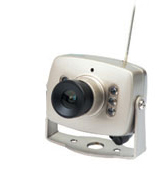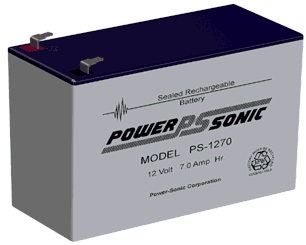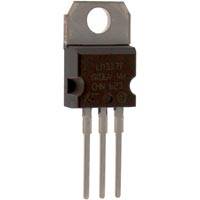Tiny wireless CCTV cameras such as the one pictured below have many uses from security surveillance to wildlife observation. Thanks to electronics miniaturisation, the images which can be obtained are excellent despite the physical size of the camera, and can be viewed on a laptop or other computer (fitted with a TV card) or on a standard television when connected to the CCTV receiver.

Wireless CCTV Cameras are the perfect application for solar power. A typical wireless CCTV camera requires just 50 to 300mA of 6.5 to 9 Volts DC electricity to operate - usually being powered by a 9 Volt battery, or via a mains adapter (not exactly wireless!).
Unfortunately, as our article High Capacity Alternative to 9 Volt Batteries describes, the capacity of a 9 Volt battery is typically very low - sufficient to power even the most efficient short-range wireless camera for just a few hours. Therefore, a PV solar panel with battery backup offers the optimal solution.
Solar Powered Wireless CCTV System
Since a wireless CCTV camera requires more than 6 Volts to operate, a 12 Volt Solar Panelshould be used. This should be connected to a battery backup so that the canera can still be used during cloudy weather, at night (if it is an infrared camera), and in the early morning and late evening when the sun is low.
Battery Storage

Either a deep-cycle sealed lead acid (SLA) or around 8 AA rechargeable batteries (in series) can be used as battery storage for the system. The initial cost of purchase of both options is similar (assuming 8 x 2,700mah AA cells, or a 2.9AH 12V SLA battery) and both have their benefits and problems.
NiMH rechargeables can release hydrogen at temperatures below zero but they are easy to purchase and can be drained fully and recharged 1,000 times.
Lead acid batteries on the other hand are heavy, cannot be delivered via the standard postal service, and should not be drained below around 40% of capacity if they are to last long. But, they cope much better with being trickle-charged, and are available in large sizes for energy hungry cameras which are to be left on 24hrs per day.
Getting the Correct Voltage to the Camera
http://www.reuk.co.uk/Solar-Powered-Wireless-CCTV.htm

http://www.reuk.co.uk/Solar-Powered-Wireless-CCTV.htm

http://www.reuk.co.uk/Solar-Powered-Wireless-CCTV.htm